
The William Cullen Bryant Homestead is the boyhood home and later summer residence of William Cullen Bryant (1794–1878), one of America's foremost poets and newspaper editors. The 155-acre (63 ha) estate is located at 205 Bryant Road in Cummington, Massachusetts, overlooks the Westfield River Valley and is currently operated by the non-profit Trustees of Reservations. It is open to the public on weekends in summer and early fall for tours with an admission fee.

The Boardman House, also known as the Scotch-Boardman House or the Bennett-Boardman House, is a historic house located at 17 Howard Street, Saugus, Massachusetts. Built about 1692, it was designated a National Historic Landmark in 1961 because of the remarkable amount of original building material still present in the house. It has been owned by Historic New England since 1914, and is open to the public on select weekends between June and October.

Valentown Hall is the name of an abandoned historic shopping and community center located in Victor, New York. The structure was built in 1879 by Levi Valentine, and today it is operated as a museum on the National Register of Historic Places.
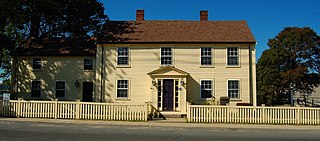
The George Peabody House Museum is a historic house museum at 205 Washington Street in Peabody, Massachusetts. It is dedicated to the life and deeds of 19th century U.S. entrepreneur, philanthropist, and namesake of the city, George Peabody. The museum shares its location with the Peabody Leather Museum. Within its walls, in 1795, George Peabody was born in what was then called South Danvers.

The Dorothy Quincy Homestead is a US National Historic Landmark at 34 Butler Road in Quincy, Massachusetts. The house was originally built by Edmund Quincy II in 1686 who had an extensive property upon which there were multiple buildings. Today, the site consists of the Dorothy Quincy Homestead, which has been preserved as a museum and is open occasionally to the public.

The Jabez Partridge Homestead is an historic farmstead at 81 Partridge Road in Gardner, Massachusetts. With its oldest part dating to about 1772, it is one of the oldest buildings in the town, built by an early settler, and is a good example of Federal period architecture. It was listed on the National Register of Historic Places in 1979.
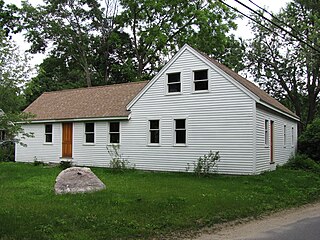
The Sawyer Homestead was a historic house at 108 Maple Street in Sterling, Massachusetts. With an estimated construction date of 1756, the house was one of Sterling's oldest surviving structures, before it was destroyed by an arsonist in 2007. It was also notable as the birthplace of Mary Sawyer, who alleged she was the subject of the American children's nursery rhyme "Mary Had a Little Lamb". The house was listed on the National Register of Historic Places in 2000. The Sawyer family, whose descendants still own the property, have had a reproduction of the house built on its site.
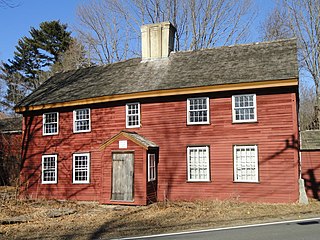
The Benjamin Abbot House or Abbot Homestead is a historic house at 9 Andover Street in Andover, Massachusetts, USA. The house was built in 1711, and is one of the oldest in Andover. It was listed on the National Register of Historic Places in 1975.
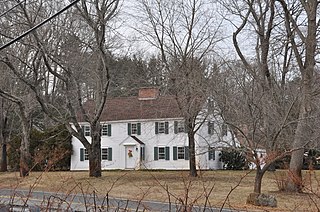
The Abbot-Baker House is a historic house at 5 Argilla Road in Andover, Massachusetts. Estimated to have been built about 1685, it is one of Andover's oldest houses, supposedly built by a third-generation colonist. It was listed on the National Register of Historic Places in 1982.

The Chestnut Street District is a historic district bounded roughly by Bridge, Lynn, Beckford, and River Streets in Salem, Massachusetts. It was added to the National Register of Historic Places in 1973 and enlarged slightly in 1978. The district contains a number of architecturally significant works of Samuel McIntire, a builder and woodworker who had a house and workshop at 31 Summer Street, and who designed and built a number of these houses, and others that display the profits made in the Old China Trade by Salem's merchants. The district is a subset of a larger locally designated McIntire Historic District.
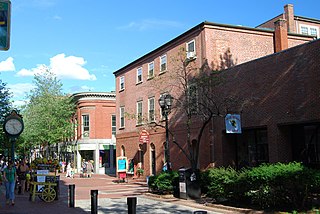
Downtown Salem District is a historic district roughly bounded by Church, Central, New Derby, and Washington Streets in Salem, Massachusetts. It was added to the National Register of Historic Places in 1983, and represents a major expansion of the Old Town Hall Historic District, which was listed in 1972.

The Hart House is a historic First Period house in Lynnfield, Massachusetts. The two story, three bay wood-frame house was built in stages. The oldest portion is the front of the house, consisting of two stories of rooms on either side of a central chimney. It was probably built by John Hiram Perkins, the owner of the property from 1695 to 1719. Not long afterward, a leanto section was added to the rear, giving the house its saltbox appearance. It was acquired by John Hart in 1838, and it remained in his family until 1945. Even though the house underwent a major rehabilitation in 1968, its First Period construction is still evident.

The Norwood-Hyatt House is a historic house at 704 Washington Street in the Gloucester, Massachusetts. It is notable as one of the oldest houses in Gloucester, and for its association with Alpheus Hyatt, who did research in marine biology here before establishing the Marine Biological Laboratory at Woods Hole.

The John Proctor House is a historic First Period house in Peabody, Massachusetts, United States. According to local tradition, this wood-frame house was occupied by John Proctor, who was convicted and hanged for witchcraft during the Salem witch trials of 1692. However, dendrochronology has determined the house was built c. 1727 by Proctor's son Thorndike, who purchased the property from Charles Downing around that time. The house remained in the Proctor family into the mid-19th century.

The Goodale Homestead is a historic First Period house located at 368 Chestnut Street in Hudson, Massachusetts, United States. The oldest portion of the 2+1⁄2-story timber-frame house dates to 1702, making it the oldest existing building in Hudson. George Francis Dow and John Goodale designed and built the house. It was later home to Goodale's various notable descendants. The house may have been a stop on the Underground Railroad. It is listed on the National Register of Historic Places.
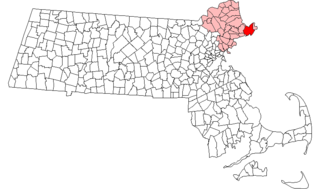
This is a list of the National Register of Historic Places listings in Gloucester, Massachusetts.

The Sawyer House, also known as the Sawyer Homestead and in its previous incarnation as the Navarre House, is a city-owned house located at 320 East Front Street in Monroe, Michigan. It was listed as a Michigan Historic Site on June 19, 1975. The house was listed on the National Register of Historic Places on November 23, 1977, and is also part of the larger Old Village Historic District.
Proctor House may refer to:

The Brayton Homestead is a historic house at 159 Brayton Avenue in Somerset, Massachusetts. Built about 1796, it is one of Somerset's oldest surviving houses, and a rare local example of Georgian/Federal residential architecture. It was built by John Brayton on land purchased by his grandfather, and remained in the family into the 20th century. The house was listed on the National Register of Historic Places in 2020.





















